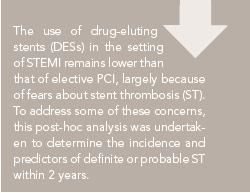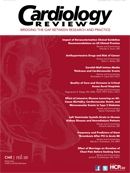Frequency and Predictors of Stent Thrombosis After Percutaneous Coronary Intervention in Acute Myocardial Infarction


Mehdi H. Shishehbor, DO, MPH
REVIEW
Dangas GD, Caixeta A, Mehran R, et al. Frequency and predictors of stent thrombosis after percutaneous coronary intervention in acute myocardial infarction. Circulation. 2011;123:1745-1756.
D
rug eluting stents (DES) have in general substantially ameliorated restenosis, the previous Achilles’ heel of percutaneous coronary intervention (PCI). However, their use has been largely limited due to concerns about stent thrombosis (ST). Although the prevalence of ST is much lower than that of restenosis, the clinical sequella of ST appear to be much more consequential and include death and myocardial infarction. The concern about ST is even greater among patients with STEMI given its higher prevalence (4.4% in the current study) compared with that of NSTEMI (~1.5%) or elective PCI (0.1-0.6%).
A number of mechanisms may explain why individuals with STEMI experience higher rates of ST. These include noncompliance, technical errors such as undersizing, and issues related to plaque morphology, inflammation, and late acquired stent malapposition (LASM). For these reasons—despite evidence from nine STEMI trials showing lower restenosis rates with DES compared with bare metal stents (BMS)—use of DES in the setting of STEMI remains lower than that of elective PCI.1
To address some of these concerns, Dangas et al conducted a post hoc analysis of Harmonizing Outcomes with Revascularization and Stents in Acute Myocardial Infarction (HORIZONSAMI) to determine the incidence and predictors of definite or probable ST within 2 years.
Study Details
Of the 3,202 patients enrolled in HORIZONS- AMI, 2,261 (71%) received only a DES and 861 (27%) only a BMS. The rate of definite or probable ST, which was adjudicated by an independent committee, was 4.4% at 2 years, with 50% of the events occurring in the acute (0.9%) and subacute (1.6%) setting, while others occurred either late (1%) or very late (1.1%). It is important to note that cumulative risk of ST was similar with both DES and BMS, as well as in patients receiving bivalirudin monotherapy or heparin plus glycoprotein IIb/IIIa inhibitors.
Acute ST occurred more frequently in the bivalirudin monotherapy group (1.4% versus 0.3%; P <0.001). Subacute, late, and very late ST was more common among those receiving heparin plus glycoprotein IIb/IIIa inhibitors. Predictors of cumulative 2-year ST include insulin dependent diabetes mellitus, angiographic aneurysm, history of PCI, current smoking, baseline Thrombolysis In Myocardial Infarction (TIMI) flow rate and platelet count, and prerandomization heparin therapy. However, the most important modifiable predictor for subacute ST was preloading with 600 mg of clopidogrel.
References
1. Brar SS, Leon MB, Stone GW, et al. Use of drug-eluting stents in acute myocardial infarction: a systematic review and meta-analysis. J Am Coll Cardiol. 2009;53:1677-1689.
2. Laarman GJ, Suttorp MJ, Dirksen MT, et al. Paclitaxel-eluting versus uncoated stents in primary percutaneous coronary intervention. N Engl J Med. 2006;355:1105-1113.
3. Valgimigli M, Campo G, Percoco G, et al. Comparison of angioplasty with infusion of tirofiban or abciximab and with implantation of sirolimus-eluting or uncoated stents for acute myocardial infarction: the MULTISTRATEGY randomized trial. JAMA. 2008;299:1788-1799.
4. Raber L, Windecker S. Data presented at China Interventional Therapeutics 2011. March 16-19, 2011, Beijing, China.
5. Guagliumi G, Costa MA, Sirbu V, et al. Strut coverage and late malapposition with paclitaxel-eluting stents compared with bare metal stents in acute myocardial infarction: optical coherence tomography substudy of the Harmonizing Outcomes with Revascularization and Stents in Acute Myocardial Infarction (HORIZONS-AMI) Trial. Circulation. 2011;123:274-281.
6. Raber L, Windecker S. Primary percutaneous coronary intervention and risk of stent thrombosis: a look beyond the HORIZON. Circulation. 2011;123:1709-1712. 7. Stone GW, Rizvi A, Newman W, et al. Everolimus-eluting versus paclitaxel-eluting stents in coronary artery disease. N Engl J Med. 2010;362:1663-1674.
COMMENTARY
Lowering the Risk of Stent Thrombosis
D
angas and colleagues have raised important unanswered questions in their analysis. First, the rate of ST at two years is substantial, and consistent with previous randomized trials such as Paclitaxel-Eluting Versus Conventional Stent in Myocardial Infarction With ST-Segment Elevation (PASSION) and Multicenter Evaluation of Single High-Dose Bolus Tirofiban versus Abciximab Sirolimus-Eluting Stent or Bare-Metal stent in Acute Myocardial Infarction Study (MULTI STRATEGY).2,3 Observational data have raised concerns about very late ST with DESs compared with BMS, and this has been collaborated by autopsy specimens showing more inflammation, fibrin deposition, and uncovered stent struts among patients with STEMI receiving DES.4
Furthermore, intravascular ultrasound (IVUS) and optical coherence tomography (OCT) data from HORIZONS- AMI also confirmed the presence of LASM and higher rates of uncovered struts with DESs compared with BMS at 13 months.5 However, despite such evidence, the current study and nine other randomized trials to date have consistently shown similar rates of ST for DESs and BMS among patients presenting with STEMI.6 The results are reassuring, but given the duration of follow-up in these trials, concerns about very late ST remains and longer-term ST data in this setting of STEMI are needed. Luckily, the majority of the trials in STEMI patients, including this study by Dangas et al, evaluated first-generation DESs, which are known to be inferior to the current 3rd-generation devices and possibly more pro-inflammatory. This is supported by the results of SPIRIT III and IV, showing a lower cumulative incidence of ST with everolimus as compared with paclitaxel-eluting stents.7,8 The ongoing Clinical Evaluation of Everolimus Eluting Coronary Stents in the Treatment of Patients With ST-segment Elevation Myocardial Infarction (EXAMINATION) should provide further safety and efficacy data for newer DESs.
The role of pharmacotherapy in preventing ST is the second important finding from this study. As noted, the higher rate of acute ST with bivalirudin is of concern, given the shift toward using this drug for STEMI to prevent bleeding. While potent antiplatelet agents such as clopidogrel may potentially ameliorate the risk, this is not supported by the current study. Clopidogrel loading did, however, reduce the risk of subacute ST. As has been shown previously, timing of the loading dose is important. 9 Newer agents, such as prasugrel and ticagrelor, may have added benefit in those receiving bivalirudin, but without 600 mg clopidogrel preloading.10 Longer infusion of bivalirudin—up to 4 to 6 hours after primary PCI—is another alternative, but the safety and efficacy of this approach has not been tested.
As noted above, the findings from this study are important but have one major limitation: lack of data on the technical aspects of all STs. Given the inflammatory nature of STEMI and the known risk of stent undersizing in this setting, supplemental imaging with IVUS or OCT are even more important. Clopidogrel preloading, if possible, is extremely important, but when not achievable, alternative agents such as prasugrel or ticagrelor should be considered, especially if bivalirudin will be the anticoagulation of choice. While difficult to achieve in an acute setting, patient compliance and ability to obtain long-term antiplatelet agents should be assessed. A comprehensive approach using 3rd-generation DESs supplemented by IVUS or OCT guidance and newer antiplatelet agents should help reduce the risk of ST in the setting of STEMI.
About the Author
Mehdi H. Shishehbor, DO, MPH, is a specialist in interventional cardiology and endovascular interventions in the Robert and Suzanne Tomsich Department of Cardiovascular Medicine at the Cleveland Clinic. He received his DO from Nova Southeastern University in Florida and a Master’s degree in public health at Cleveland State University. He is presently working on a doctorate in epidemiology at Case Western Reserve University. He is widely published on cardiovascular epidemiology, interventional cardiology outcomes, and techniques, and is co-author of a book on coronary intensive care.
